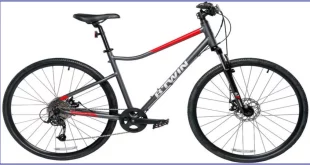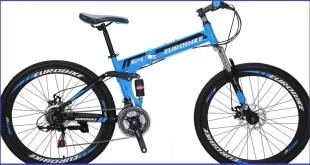A road bike is typically better than a mountain bike for commuting due to its faster speed and more efficient design. In urban areas, where roads are generally smooth and well-maintained, road bikes offer a faster and smoother ride, making them ideal for commuting.
They have narrow tires, lightweight frames, and drop handlebars, which allow for better aerodynamics and reduced rolling resistance. This enables riders to cover longer distances with less effort and time. On the other hand, mountain bikes are built for off-road trails and rough terrains, which makes them slower and less suitable for urban commuting.
While mountain bikes offer more durability and stability, their heavier weight and wider tires result in decreased speed and increased effort on paved roads. Therefore, if your primary purpose is commuting on city roads, a road bike would be a wiser choice, offering a more efficient and enjoyable ride.
The Advantages Of Using A Road Bike For Commuting
If you’re considering using a bike for your daily commute, you may be wondering whether a road bike or a mountain bike would be the better option. While both types of bikes have their merits, road bikes offer several advantages when it comes to commuting.
In this section, we’ll explore the key advantages of using a road bike for your daily journeys.
Faster Speeds And Better Efficiency
One of the primary advantages of using a road bike for commuting is its ability to achieve faster speeds and better efficiency. Here’s why:
- Road bikes are designed for speed, with lightweight frames, thin tires, and aerodynamic designs. This allows riders to reach higher speeds with less effort, making for quicker commutes.
- The narrow tires of road bikes reduce rolling resistance, making it easier to pedal and maintain a consistent pace. This efficiency can save you precious time during your daily commute.
Lightweight And Maneuverable
Another key advantage of road bikes for commuting is their lightweight and maneuverable nature. Consider the following points:
- Road bikes are typically much lighter than mountain bikes, thanks to their lighter frames and components. This makes them easier to handle and maneuver in traffic or tight spaces.
- The lightweight construction also means road bikes require less effort to accelerate and decelerate. This improved agility can be particularly beneficial when navigating busy city streets or congested areas.
Designed For Paved Roads
Road bikes are specifically designed for paved roads, which makes them well-suited for commuting on urban streets or smooth surfaces. Take a look at the following details:
- The narrow tires of road bikes provide optimal traction and control on paved surfaces. This ensures a smooth ride and minimizes the risk of skidding or sliding.
- Road bikes also feature a more aggressive riding position, allowing riders to maintain better visibility and handle various traffic situations effectively.
More Suitable For Longer Commutes
Lastly, road bikes are often more suitable for longer commutes. Here are the reasons why:
- The efficiency and speed of road bikes make them ideal for covering greater distances in a shorter amount of time. This can be especially advantageous if your commute involves longer routes or highways.
- Road bikes typically offer more comfortable and efficient pedaling positions, reducing the strain on your body during extended rides. This can make your daily commute more enjoyable and less tiring.
Road bikes offer several advantages for commuting. Their faster speeds, better efficiency, lightweight construction, maneuverability, and suitability for paved roads make them an excellent choice for those looking to cycle their way to work or any other destination. Consider these advantages when deciding which bike is best for your commuting needs.
The Advantages Of Using A Mountain Bike For Commuting
Mountain bikes are not just meant for tackling rugged terrains and thrilling trails; they can also be an excellent choice for commuting purposes. In fact, using a mountain bike for your daily commute comes with some distinct advantages. So, if you’re wondering whether a mountain bike is better than a road bike for commuting, let’s delve into the advantages that make it a favorable option.
Versatility And Off-Road Capability
- Mountain bikes are designed to handle a wide range of terrains, from rocky trails to paved roads. This makes them incredibly versatile for commuting.
- The off-road capability of mountain bikes allows riders to take alternative routes, such as shortcuts through parks or forested areas, making your commute more enjoyable and adventurous.
Ability To Handle Different Terrains
- One of the primary advantages of using a mountain bike for commuting is its ability to handle various terrains. Whether it’s pothole-ridden city streets or bumpy gravel paths, a mountain bike can tackle them with ease.
- Unlike road bikes, mountain bikes feature wider tires with more traction, providing better stability and control on uneven surfaces.
Enhanced Stability And Control
- Mountain bikes typically have a more upright riding position, allowing for better visibility and control in traffic.
- The wider handlebars of mountain bikes offer enhanced stability, making them suitable for navigating through crowded areas or when encountering unexpected obstacles on your way to work.
Suitable For Shorter And Varied Commutes
- If your daily commute involves shorter distances or includes a mix of different terrains, a mountain bike can be the perfect choice.
- The agility and maneuverability of mountain bikes make them ideal for navigating through tight spaces or weaving in and out of traffic.
Using a mountain bike for commuting offers several advantages in terms of versatility, terrain adaptability, stability, and suitability for shorter and varied commutes. So, if you’re looking for a bike that can handle any road condition while adding a sense of adventure to your daily commute, a mountain bike might just be the perfect fit.
Factors To Consider When Choosing Between A Road Bike And A Mountain Bike
Choosing the right bike for your daily commute can make a world of difference in your overall experience and comfort. As you weigh the options between a road bike and a mountain bike, several factors come into play. Let’s delve into the key considerations to help you make an informed decision.
Distance And Route Of The Commute
- For shorter distances on even surfaces, a road bike is often the preferred choice. Its sleek design and lightweight frame allow for greater speed and efficiency on paved roads.
- If your commute involves longer distances, a mountain bike may offer more comfort and stability. The wider tires and suspension can absorb bumps and rough patches on the road, reducing physical strain during a lengthier ride.
- Consider the terrain of your route as well. Road bikes excel on smooth pavements, while mountain bikes are better suited for off-road trails and uneven surfaces.
Road Conditions And Terrain
- Road bikes are designed for smooth surfaces and perform optimally on paved roads. The narrow tires and drop handlebars provide increased traction and maneuverability on well-maintained streets.
- On the other hand, if your commute involves rough roads, potholes, or unpaved paths, a mountain bike’s sturdy frame, wider tires, and suspension can handle these challenges with ease.
Personal Preference And Comfort
- Your personal preferences and comfort play a significant role in deciding between a road bike and a mountain bike for commuting. Some individuals prefer the speed and agility of a road bike, enjoying the exhilarating ride it offers.
- Others prioritize comfort and may opt for a mountain bike’s more upright riding position and shock absorption. This can be particularly beneficial if your commute involves longer durations or hilly terrains.
Budget And Cost Considerations
- Budget is an essential factor to consider when purchasing a bike. Road bikes tend to be more expensive than mountain bikes, as they are designed for high-performance road cycling.
- However, mountain bikes offer versatility and durability, making them a cost-effective option for daily commuting that can handle various terrains.
Ultimately, the choice between a road bike and a mountain bike for commuting depends on your specific needs and preferences. Consider factors such as distance, road conditions, personal comfort, and budget to make an informed decision that will enhance your daily commute experience.
Remember to test ride different bikes to determine which one suits you best.
Road Biking Vs. Mountain Biking: Which Is Safer For Commuting?
Road biking and mountain biking are two popular options for commuting, each with their own set of advantages and considerations. When it comes to safety, it’s important to understand the differences between the two and choose the one that best suits your needs.
In this section, we will explore the safety aspects of road biking and mountain biking for commuting, highlighting the key points for each. Additionally, we will discuss the importance of proper safety gear and precautions that should be taken when cycling on roads or trails.
Road Biking Safety Considerations:
Road biking offers a smooth and efficient ride on paved surfaces, making it a popular choice for urban commuters. However, it also comes with certain safety considerations:
- Sharing the road with motor vehicles can be challenging, so being visible to drivers is crucial. Wearing bright-colored clothing and using reflective accessories can significantly improve your visibility.
- Obeying traffic rules and signals is essential for your safety as a road cyclist. Be sure to follow speed limits, use hand signals for turns, and ride predictably.
- Riding defensively is important when dealing with traffic. Always anticipate the actions of motorists and watch out for potential hazards such as potholes, debris, or parked vehicles that may open their doors unexpectedly.
- Investing in a good set of lights for your bike is essential, especially if you commute during low-light conditions. It will improve your visibility to other road users and increase your safety on the road.
Mountain Biking Safety Considerations:
Mountain biking, on the other hand, provides a thrilling off-road experience, but it comes with its own safety considerations:
- Riding on uneven terrain and challenging trails requires a higher level of skill and experience. Beginners should start with beginner-friendly trails and gradually build up their skills.
- Wearing a well-fitted helmet is of utmost importance when mountain biking. It protects your head in case of a fall or collision with obstacles on the trail.
- Proper bike maintenance is crucial for safety. Regularly check your brakes, tires, and suspension to ensure they are in good working condition.
- Pay attention to your surroundings on the trail, as unexpected obstacles like rocks, roots, and branches can pose a risk. Always maintain control of your bike and ride within your limits.
Importance Of Proper Safety Gear And Precautions:
Regardless of whether you choose road biking or mountain biking for commuting, proper safety gear and precautions are essential for a safe riding experience:
- A well-fitted helmet should always be worn, as it protects your head from potential injuries in case of accidents.
- Cycling gloves provide better grip on the handlebars and protect your hands in case of falls.
- Reflective gear, such as vests or ankle bands, enhances your visibility to others especially during low-light conditions.
- Knee and elbow pads can offer protection against injuries in case of falls.
- Regular maintenance of your bike, including checking the brakes, tire pressure, and ensuring proper functioning of all components, is crucial for safe riding.
Remember, safety should be a top priority when it comes to commuting on a bike. Whether you choose road biking or mountain biking, following these safety considerations and using the right gear will help ensure a safe and enjoyable riding experience.
So pick the option that suits your preferences and enjoy your ride to work or wherever your destination may be.
Road Bike Modifications For Commuting
Commuting by road bike can be a great way to get around town quickly and efficiently. However, to make your road bike more suitable for everyday commuting, a few modifications can go a long way. By adding fenders and racks for carrying items, installing lights for visibility on roads, and choosing appropriate tires for urban commuting, you can enhance your road bike for a more comfortable and practical commuting experience.
Adding Fenders And Racks For Carrying Items
- Fenders: Attaching fenders to your road bike will protect you from splashes and dirt, especially during wet weather conditions. These lightweight accessories can be easily installed and will keep you cleaner and drier during your commute.
- Racks: Installing a rack on your road bike will provide a convenient solution for carrying items such as a backpack, groceries, or a change of clothes. Look for racks specifically designed for road bikes to ensure proper fit and weight distribution.
Installing Lights For Visibility On Roads
- Front lights: It is essential to be visible to other road users, especially during low-light conditions. Invest in a high-quality front light that emits a bright beam, alerting others to your presence on the road.
- Rear lights: Equally important is a rear light that emits a steady or flashing red light, alerting those behind you to your presence. Choose a light with multiple brightness settings to suit different lighting conditions.
Choosing Appropriate Tires For Urban Commuting
- Durability: Opt for tires that offer good durability and puncture resistance, as they will withstand the challenges of urban commuting. Look for models with reinforced sidewalls and tread patterns designed for increased grip and longevity.
- Width: Consider wider tires that offer a smoother ride on rough road surfaces. The additional volume provides extra comfort and stability, especially when encountering potholes or uneven pavement.
- Tread pattern: For city commuting, tires with a smooth or low-profile tread are ideal. These tires provide reduced rolling resistance, allowing you to maintain higher speeds with less effort on paved surfaces.
By making these modifications, you can transform your road bike into a commuter-friendly machine. Whether it’s the addition of fenders to keep you clean and dry, racks for carrying your everyday items, lights for enhanced visibility, or appropriate tires for urban riding, these modifications will enhance your overall commuting experience.
So hop on your modified road bike and enjoy a smooth, efficient, and enjoyable ride to work or wherever your daily adventures take you.
Mountain Bike Modifications For Commuting
Are you torn between choosing a road bike or a mountain bike for your daily commute? While both options have their advantages, mountain bikes can be a fantastic choice with a few modifications. By adding racks and baskets for carrying items, installing lights for visibility off-road, and choosing appropriate tires for mixed terrains, you can transform your mountain bike into the ideal commuting companion.
Let’s explore these modifications in more detail.
Adding Racks And Baskets For Carrying Items:
- With the addition of racks and baskets, you can conveniently transport essentials such as groceries, a change of clothes, or even your laptop.
- Racks can be easily attached to the rear wheel or mounted on the bike frame, providing a sturdy surface to secure panniers or bags.
- Baskets offer a simple and accessible solution for carrying smaller items like your backpack, lunch, or water bottle.
- These modifications ensure that you can commute comfortably and efficiently, without the need for an additional backpack or messenger bag.
Installing Lights For Visibility Off-Road:
- Commuting in low-light conditions or during the evenings can be hazardous, especially if your route includes off-road sections. Installing lights on your mountain bike is crucial for maintaining visibility and enhancing safety.
- Front lights help illuminate the trail or road ahead, improving your ability to see obstacles and potential hazards.
- Rear lights make you more visible to other road users, reducing the risk of accidents.
- Choose lights with different brightness levels and adjustable modes to suit your needs and conserve battery life.
Choosing Appropriate Tires For Mixed Terrains:
- Mountain bikes typically come equipped with wide, knobby tires designed for off-road adventures. However, when using your mountain bike for commuting, opting for tires suitable for mixed terrains can significantly improve your riding experience.
- Consider tires with a smoother tread pattern to reduce rolling resistance and increase efficiency on paved roads.
- Look for tires with puncture-resistant layers to minimize the chances of encountering flats.
- Balancing traction and speed is crucial, so find tires with a versatile tread that can handle both pavement and off-road sections.
By making these modifications to your mountain bike, you can transform it into a reliable and efficient commuting machine. With racks and baskets for carrying items, lights for off-road visibility, and suitable tires for various terrains, you’ll enjoy a comfortable and safe ride to work or wherever your daily commute takes you.
Say goodbye to traffic jams and embrace the freedom of two wheels on your modified mountain bike.
The Impact Of Weather Conditions On Road Biking And Mountain Biking
Are you torn between using a road bike or a mountain bike for your daily commute? The choice can be a tough one, as both types of bikes have their advantages and disadvantages. In this blog post, we will explore the impact of weather conditions on road biking and mountain biking, helping you make an informed decision based on your local climate.
How Road Bikes Perform In Different Weather Conditions:
- Road bikes are designed for speed and efficiency on paved surfaces, making them ideal for commuting on dry, sunny days.
- With their lightweight frames and narrow tires, road bikes excel in fair weather conditions, allowing you to quickly navigate through traffic and reach your destination in record time.
- However, road bikes are not as well-suited for inclement weather, as their tires provide less traction and stability on wet, icy, or snowy roads.
- Riding a road bike in heavy rain or strong winds can be challenging, as their aerodynamic design can make them more susceptible to gusts and a wet road surface can increase the risk of sliding.
How Mountain Bikes Handle Various Weather Conditions:
- Mountain bikes, on the other hand, are built to handle a wide range of terrains, including rough trails and uneven surfaces, making them a more versatile option for commuting in unpredictable weather conditions.
- Their wider, knobby tires offer more traction and stability, making it easier to ride on wet or slippery surfaces.
- Mountain bikes also tend to have stronger brakes and a more upright riding position, which can be advantageous in navigating through puddles or snow.
- While mountain bikes may not be as fast as road bikes on dry roads, they provide a smoother and more comfortable ride in adverse weather conditions.
Tips For Navigating Wet, Icy, Or Snowy Conditions On Both Types Of Bikes:
Road bike tips:
- Consider switching to wider tires with more grip to improve traction in wet conditions.
- Reduce your speed and be cautious when cornering on wet or icy surfaces.
- Brake earlier and use gentle, gradual pressure to prevent skidding.
- Be extra mindful of painted road markings, as they can become extremely slippery when wet.
Mountain bike tips:
- Lower your tire pressure slightly to increase traction on wet or snowy surfaces.
- Adjust your riding position and lean back to maintain stability on slippery terrain.
- Use your brakes judiciously, applying firm and steady pressure to avoid losing control.
- Keep an eye out for hidden hazards, such as patches of ice or hidden puddles.
Remember, the right choice between a road bike and a mountain bike for commuting depends on your personal preferences and the prevailing weather conditions in your area. Now that you have a better understanding of how each bike performs in different weather conditions, you can make an informed decision that ensures a safe and enjoyable commute to work.
Frequently Asked Questions Of Is A Road Bike Better Than A Mountain Bike For Commuting?
Can I Use A Road Bike For Commuting?
Yes, a road bike can be a great option for commuting. It offers speed and efficiency on smooth roads, making your commute faster and easier. Just make sure to equip it with proper lights, fenders, and a rack for carrying your belongings.
Is A Mountain Bike Suitable For Commuting?
Yes, a mountain bike can be a suitable choice for commuting, especially if you encounter rough terrains or unpaved paths during your commute. Its sturdy build, suspension, and wider tires provide stability and comfort, making your ride enjoyable and versatile.
What Are The Advantages Of A Road Bike For Commuting?
A road bike offers several advantages for commuting. It’s lightweight, aerodynamic design allows you to go faster on paved roads. Its narrow tires decrease rolling resistance, making your ride more efficient. Additionally, its drop handlebars provide various hand positions, reducing fatigue during long commutes.
What Are The Advantages Of A Mountain Bike For Commuting?
A mountain bike has its own set of advantages for commuting. Its durable frame and suspension system absorb road vibrations, providing a smoother ride. The wider tires offer better traction and stability on uneven surfaces. Also, mountain bikes often come with multiple gears for tackling different conditions.
Which Bike Is More Comfortable For Commuting, Road Or Mountain?
The choice between road and mountain bike comfort depends on your preferences and the condition of your commute route. If you mostly ride on smooth roads, a road bike’s lightweight design and efficient geometry offer a more comfortable experience. But if your commute involves off-road sections or rough surfaces, a mountain bike’s suspension and wider tires will provide better comfort.
Can I Customize My Road Or Mountain Bike For Commuting Purposes?
Absolutely! Both road and mountain bikes can be customized for commuting needs. You can add accessories like lights, fenders, racks, panniers, or baskets to carry your belongings. Additionally, you can adjust the bike’s seating position, handlebars, or tires according to your comfort and preference.
Customization options are plentiful, so you can tailor your bike to meet your specific commuting requirements.
Conclusion
To conclude, choosing between a road bike and a mountain bike for commuting ultimately depends on your personal preferences and the specific requirements of your commute. Road bikes are designed for speed and efficiency on paved surfaces, making them ideal for urban commuting where speed is a priority.
On the other hand, mountain bikes offer versatility, durability, and better adaptability to rough terrains or off-road paths. Consider factors such as distance, terrain, weather conditions, and your riding style before making a decision. Also, don’t forget about the importance of comfort and safety when choosing the right bike for your commute.
Investing in quality components, like puncture-resistant tires or a lightweight frame, can enhance your riding experience and make your commute more enjoyable. Regardless of the bike you choose, regular maintenance and safe riding practices are essential to ensure a smooth and secure journey.
So, analyze your needs, take into account the advantages and disadvantages of each type of bike, and make an informed decision based on what will best suit your commuting needs.
 CommutingLife Explore The World On Two Wheels
CommutingLife Explore The World On Two Wheels





